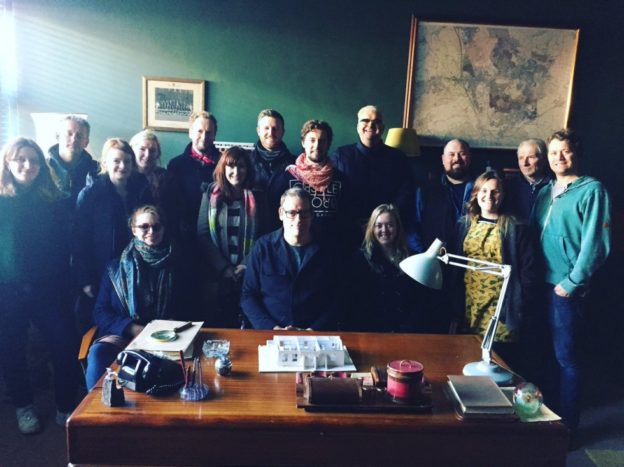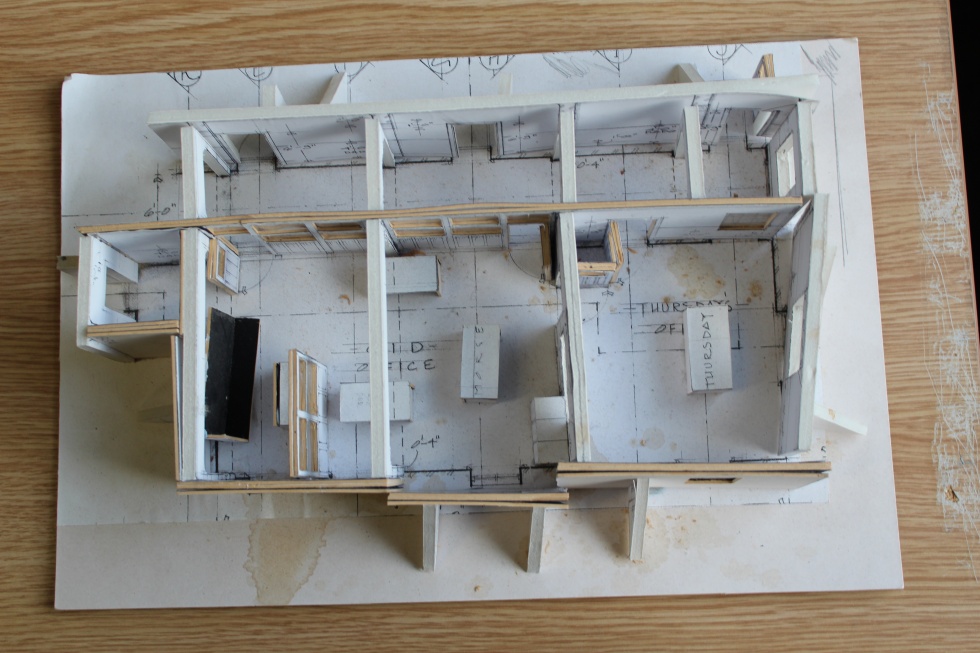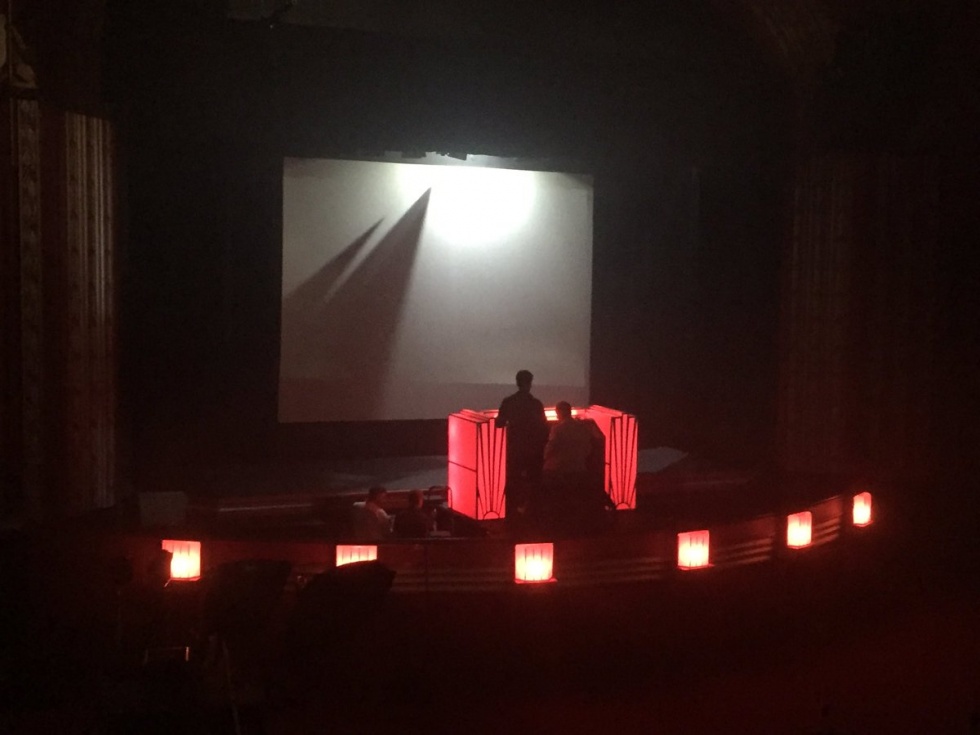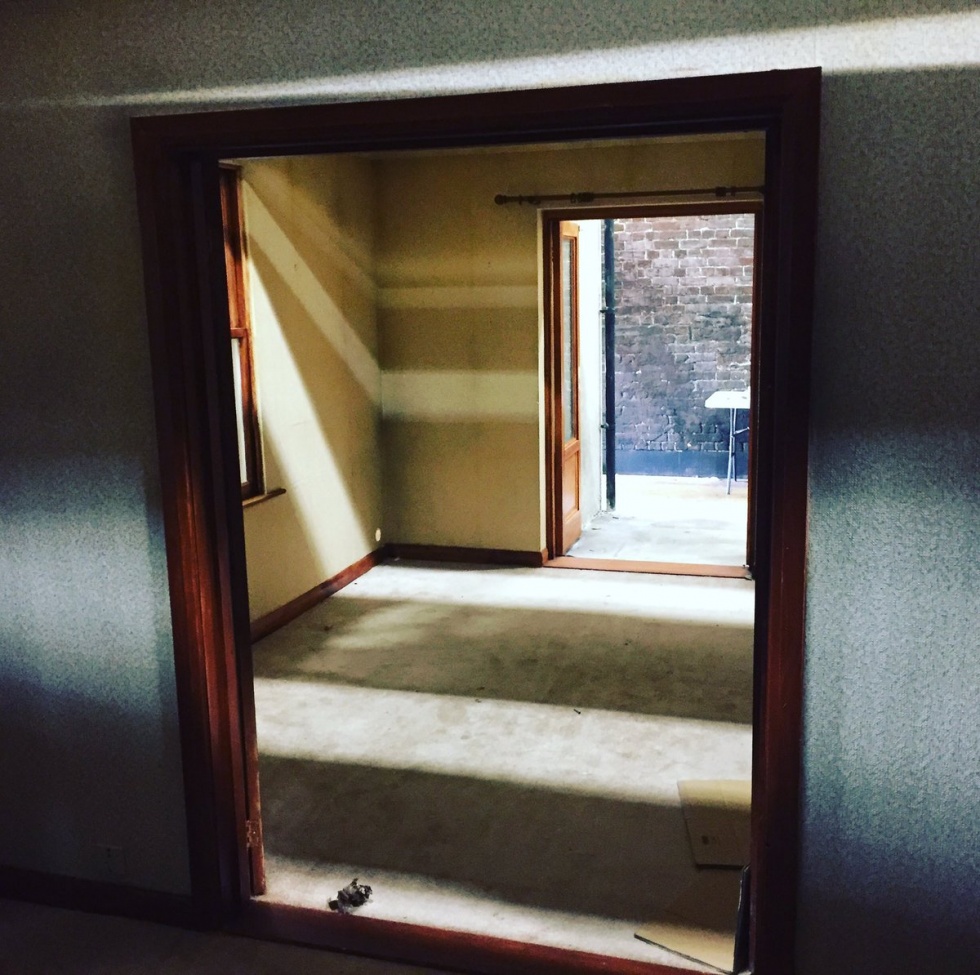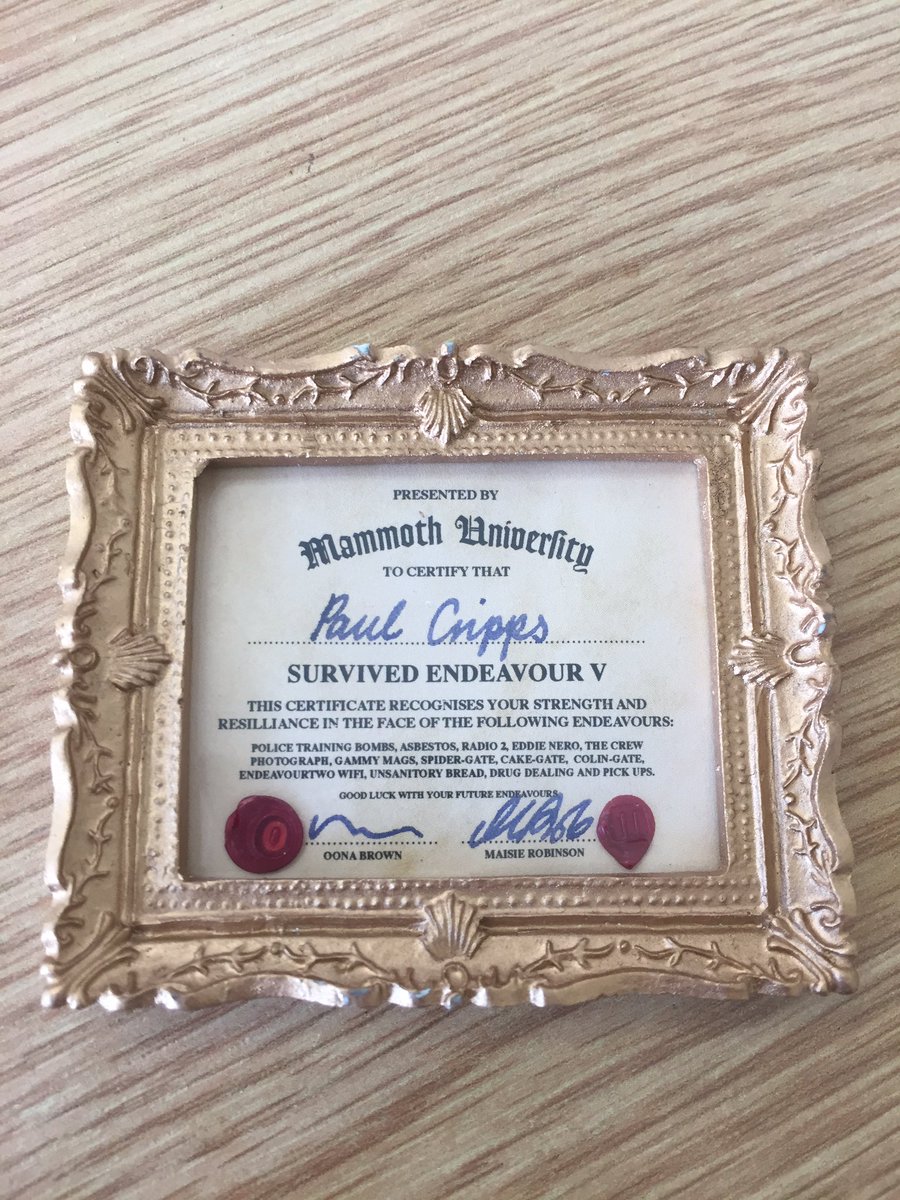Above photo courtesy of Paul Cripps (centre)
An exclusive ENDEAVOUR interview
PAUL CRIPPS
Production Designer
Interview copyright © Damian Michael Barcroft 2018
~
DAMIAN: Having lived in Oxford, I wonder to what extent you were aware of Inspector Morse growing up?
PAUL: I was aware of Inspector Morse for a few reasons. I think it started filming around 1987 when I was finishing my A Levels and I grew up in Woodstock and obviously the first Colin Dexter Morse novel was Last Bus to Woodstock. I knew the TV series was set and partly filmed in Oxford so there was a local buzz about it. Also my dad was a friend of Peter Woodthorpe the actor who played the original Max De Bryn. They did their national service together at the Joint Services School for Linguists training as Russian translators.
DAMIAN: Before we talk anymore about Morse, I’d like to ask you about the kind of films or television which may have inspired you to consider the art of production design. Do you have any particularly vivid early memories of trips to the cinema and specific films that may have had an influence?
PAUL: That’s easy, I was a Star Wars kid. I queued round the block to see it several times in 1977. And then in 1978 Harrison Ford came to film in Woodstock my home town for a WW2 film called Hanover Street with Christopher Plummer and Lesley Anne Down. So naturally I was desperate to see him, my sister got him to give us his autographs (my middle sister also works in Film and TV and does big movies like Wonder Woman and Darkest Hour). But also our whole town was turned into a WW2 Nazi occupied French town. Blenheim Palace became the local chateau turned into the German army headquarters. My grandmother’s Florist shop was turned into a Boulangerie. There were gun battles and car chases and Musco lights above the town for two weeks. That fascinated me. Then other films came. I watched Mel Brooks recreate the French Revolution at Blenheim Palace for History of the World Part One. I also failed to get an extras part in Another Country and watched them filming it in the Turl. So I wanted to work in film and TV but didn’t know how.
DAMIAN: If you were to compile a top ten of your favourite production designs from the movies what would such a list look like?
PAUL: Hmm, tricky… off the top of my head, lots of Kubrick: 2001, The Shining, lots of Greenaway: The Draughtsman’s Contract, Belly of an Architect, The Cook, The Thief… lots of Sci Fi: Bladerunner, The Star Wars original trilogy, Alien, Dark Star, Tarkovsky’s Mirror, Stalker and The Sacrifice. David Lean’s Oliver Twist and Lawrence of Arabia… Fight Club, Zodiac, All The President’s Men, Brazil, Time Bandits, Kagemusha, Spring Summer Fall Winter Spring, Mon Oncle, In the mood for love. I could go on…
DAMIAN: Can you tell me about your training and at what exact point you decided to pursue a career in production design?
PAUL: I always wanted to work in TV or film but I started doing an art foundation course and was pointed towards fashion. I finally went and did a BA in theatre design at Wimbledon school of art. I worked for a year after that (my first job was costume assistant on a Ridley Scott ad for BP for Charles Knode) and then I went to do an MA in Film and TV Design at the Royal College of Art. I started working in design for entertainment chat shows, music shows, game shows. I worked on TFI Friday for quite a while. Then I moved across and started doing TV drama and films.
DAMIAN: Looking through your credits which include The Missing, You, Me and the Apocalypse, Atlantis, Skins and Merlin, I was fascinated to learn that you worked on both of the Judge Dredd movies; as a trainee in the art department on the 1995 Sylvester Stallone production and then the more recent one in 2012 as art director. Is this pure coincidence or are you a fan of 2000 AD Comics?
PAUL: I had every issue of 2000 AD as a kid but it was pure luck working on both. I got a work placement on the Stallone Dredd for about three weeks making models and tea in the art dept. There were some great people on that film: Nigel Phelps, Leslie Tompkins, Peter Young, David Allday, Chris Cunningham. Then I was doing Never Let Me Go with my friend Mark Digby and DNA were talking about Judge Dredd so I did some Pre budgeting and visuals but then for various reason didn’t work on it in South Africa but then they did a whole load of reshoots and extra bits in London and asked me to do them.
DAMIAN: Before we go any further, could you just clarify for those who are perhaps new to the subject, what the differences are between an art director and a production designer?
PAUL: Basically the Production Designer is the boss, the one with the complete vision and the art director is his or her right hand person who implements the realisation of that vision, dealing with construction of sets, drawing up and handing jobs out to the various members of the art and props department. The other right hand people are the set decorator; who helps with the choices of furniture and decoration for each scene; and the propmaster who organises he dressing of the sets. I had two talented women in those roles for Endeavour. Stacey Dickinson the art director and Faye Brothers the set decorator and trusty sidekick Simon Drew as propmaster.
DAMIAN: Back to Mega-City One, the first Dredd film was a critical and commercial flop, the fans hated it but it must have been huge fun to work on?
PAUL: It WAS great! My friend Andrea the actual art dept assistant has some great photos. Seeing them build the Mega City One streets in the Shepperton car park was amazing. If you look carefully all the shops are named after puns of people in the art dept. My two favourites were Bill Ying Tong’s Chinese restaurant named after John Billington and The All Day and Night Diner after David Allday.
DAMIAN: I thought the Karl Urban 2012 film was pretty good and did much to restore the hopes of fans for a decent and well deserved faithful comics-to-screen franchise – what happened?
PAUL: Sadly the success of a film called The Raid and being too similar did it for Dredd really I think. I think The Raid came out first and stole our thunder. I think the financial backing came from India and not a recognised studio and it just didn’t make enough money to warrant a sequel for DNA unlike 28 Days Later which was an unexpected hit.
DAMIAN: How did you come to work on Endeavour?
PAUL: Well I’ve mostly done contemporary drama and apart from some fantasy I’ve never really done proper period so I’ve been looking to try and find something like Endeavour to do. A few other shows I was mooted for, that shall remain nameless, didn’t happen so I was kicking around not doing anything much. I read MUSE and met John the producer and I think we really got on so that was it.
DAMIAN: Endeavour has had various previous production designers: Pat Campbell did First Bus to Woodstock (or “Pilot”), and then Matt Gant, Anna Higginson, Anna Pritchard and Alison Butler for the subsequent series that followed. Did you look at their work as part of your research or for reference before you started your own designs and is it more challenging to take over from previous artists or more artistically rewarding to start from scratch?
PAUL: When I got the job I went back and watched every single episode of Endeavour. The one thing about Endeavour is that most single episodes look different, each has its own feel and look and that’s what was interesting for me. You don’t really have to reproduce the look just the quality. This is only the second time I’ve not done the first series of a programme, so it’s unusual for me to follow someone but I took Endeavour as it was one of the shows on TV that I actually watched and liked. Plus my personal connection to Oxford and being born in 1968 in Oxford I couldn’t not do it!
DAMIAN: And is it generally more fun to work on something period, contemporary, futuristic or does really just depend on the project?
PAUL: I think for me it depends on the project, particularly the script and the other people working on the project. Script sells it a lot of the time. And much to my agent’s dismay I’m quite fussy about scripts.
DAMIAN: Which books or websites proved to be the most useful in researching Endeavour’s Oxford of 1968?
PAUL: Probably one of the best sources was the Oxford History Centre which I spent a few days at in Pre Production. It’s in Cowley and holds all the council archives and a fabulous photo library. The council had done a survey of pubs in 1968 which proved useful ref. They also hold microfiche of Oxford Mail’s and Times from the period. I found a few of my Mum’s advertising drawings popping up as I was searching the papers. We also visited a guy who runs the Oxford/Thames Valley Constabulary archive which again was a really useful source.
DAMIAN: Presumably you see the script and then start making notes but can you take me through your pre-production process as a production designer using Endeavour as an example?
PAUL: I read the scripts as they come through. Then talk to the director and then he and I and the location people spend weeks driving round finding locations. Also I’m designing any sets that need building such as Strange and Endeavour’s shared maisonette from this series.
I tend to start with plans moving into 3D renderings using a programme called SketchUp. Then we do drawings for the construction people. When the locations and sets are all decided we do what’s called a tech recce and the heads of departments and key crew all get in a bus and drive round every location and decide how every scene will be shot. I then talk with my crew deciding how we will dress and strike the locations and then Faye and or myself will go off and chose furniture and furnishings. Stacey and I will decide on what needs constructing and painting, vehicles and graphics and Simon will do a dressing and strike schedule all in relation to the main schedule. Finally I like to go to the readthrough as that really begins to bring the whole thing together and helps me character wise for various settings. Then the shoot starts.
DAMIAN: And then when it’s actually production time and the cameras are ready to roll, can you describe a typical day on set – series five of Endeavour had a particularly brutal schedule but perhaps the very first day of shooting would be the most illuminating example?
PAUL: Well I’m actually not on set much. We normally as an art dept work ahead and behind the shooting crew. So we will go in the day or a couple of days before the shoot and dress the set or location. I will come on the morning of the shoot and check everything is to the liking of the director and DOP and then troubleshoot if required. But I will try to leave as quickly as possible as I will be onto dressing the set for the next day or next section. Also Simon and his crew will return the day after the shoot (or sometimes the night of!) to return the location back to how it was when we arrived. The schedule is often relentless. Often on Endeavour I usually arrived on set once the set was already dressed as the day we started shooting each film was usually the day the next director started and so the whole process of location hunting on the next film would start all over again!
DAMIAN: How many different sets or locations might you need to prepare for an average day’s shoot?
PAUL: Well it varies, sometimes there are two or more sets or locations in a day so we will dress one the day before and one on the morning whilst the crew is shooting the first one. Then once they have moved to the second location we will return and ‘strike’ the first location. Generally it’s one or more locations a day for twenty odd days. Sometimes we are in a location for several days so we can get some respite and recover and re-plan or re-group.
DAMIAN: Is it easier to design sets for location or studio filming?
PAUL: It’s sometimes easier with a set in a studio as locations can have specific problems or issues but then you have to get a studio set to look and feel real. There lots to love and lots to frustrate in both.
DAMIAN: To what extent does production design necessitate a creative collaboration with other departments such as the art director, set decoration or location manager?
PAUL: The art director and set decorator are all in my team so collaboration is essential. And of course there is collaboration with lots of people; locations, costume, DOP etc. Probably the most important are the DOP and location manager. If you don’t find good or the right locations the job is much harder and if the DOP does not light your sets or locations well it won’t matter how well you’ve designed them!
DAMIAN: Where were the Roxy cinema interior and exterior scenes filmed in CARTOUCHE?
PAUL: The exterior, foyer, bar, owner’s flat and roof were all the former Carlton cinema in Essex Road Islington currently a church. The auditorium was the Broadway Theatre Catford with additions by me including an orchestra pit and the rising organ (a hydraulic lift!) Interestingly the auditorium was an almost exact match of a cinema I location scouted in Germany for The Missing 2 for BBC. That cinema was built around the same time in a Nazi training camp called Vogelsang and when I went to Catford for the first time I was astounded by the similarity. We saw a lot of abandoned cinemas for CARTOUCHE it was heartrending seeing the dilapidation of the State cinema in Grays.


 DAMIAN: The rising organ very much reminded me of the two Dr Phibes films from the seventies. Were these a particular influence?
DAMIAN: The rising organ very much reminded me of the two Dr Phibes films from the seventies. Were these a particular influence?
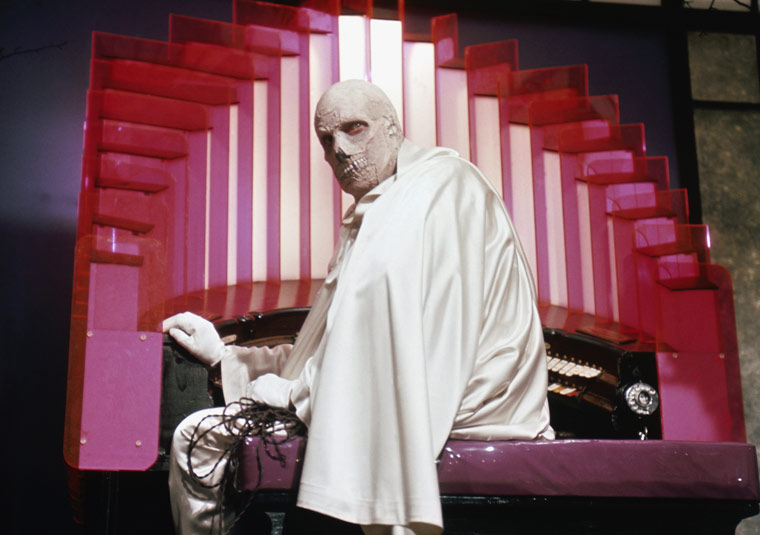 PAUL: Actually no I’m afraid to say. I was influenced more by the organ at one of the potential cinema locations we recce’d; The State Cinema in Grays, Essex.
PAUL: Actually no I’m afraid to say. I was influenced more by the organ at one of the potential cinema locations we recce’d; The State Cinema in Grays, Essex.
Also I remembered the two remaining organs in Leicester Square one of which I saw playing at the London Film Festival screening of Never Let Me Go.
DAMIAN: As regular readers will know, CARTOUCHE was a particular delight for me as a huge fan of the Universal and Hammer Horrors. To what extent were these a direct influence on your designs and did you research specific films or the work of production designers for Universal such as Charles D. Hall or Bernard Robinson at Hammer?
PAUL: Yes I was very influenced by the 60’s Hammer output. I watched quite a few and the location at an old abandoned school near Wallingford worked really well for the film within a film. I remember watching a lot of those films when I first went to film school at the Prince Charles Cinema late night screenings.
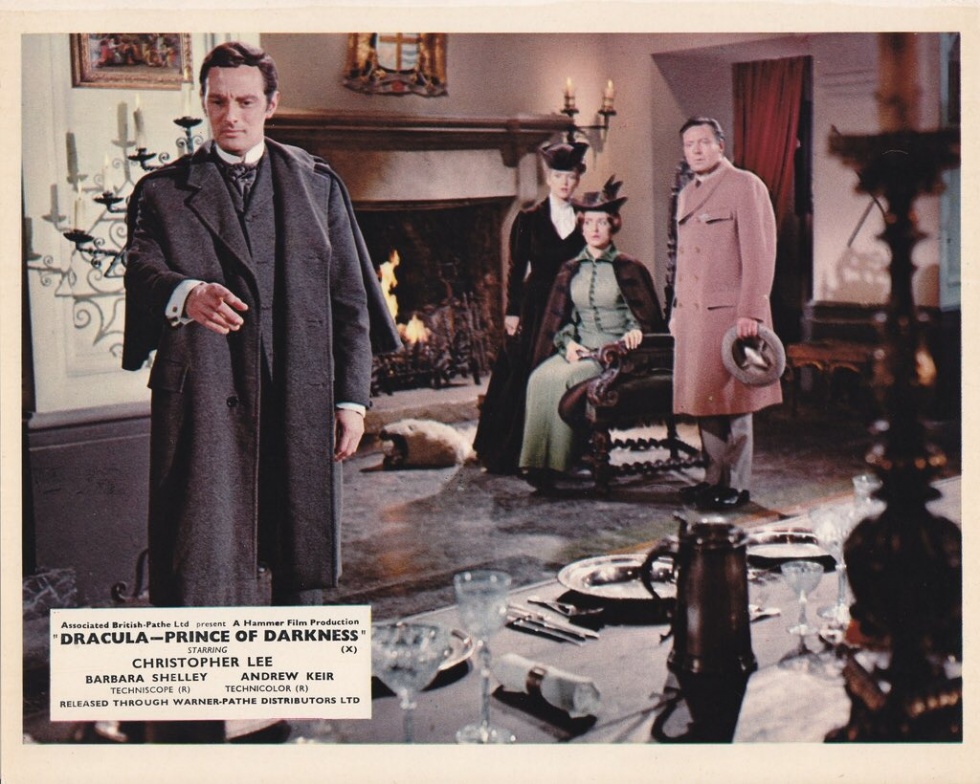 I also sought out some behind the scenes photos at the BFI library. The book, Hammer Films – The Unsung Heroes The Team Behind the Films was a really useful reference for the filmmaking scenes. My favourite note was that Peter Cushing wore a single white glove when smoking off camera so as not to stain his fingers!
I also sought out some behind the scenes photos at the BFI library. The book, Hammer Films – The Unsung Heroes The Team Behind the Films was a really useful reference for the filmmaking scenes. My favourite note was that Peter Cushing wore a single white glove when smoking off camera so as not to stain his fingers!
 DAMIAN: I know the writer, Russell Lewis, is also crazy about these films so I’m wondering if there were many phone calls and emails back and forth in discussing the right look and feel for the film?
DAMIAN: I know the writer, Russell Lewis, is also crazy about these films so I’m wondering if there were many phone calls and emails back and forth in discussing the right look and feel for the film?
PAUL: Well I have to say that Russ is the ultimate professional in that he never really calls me to demand we do this or that and I’m sure some of the things we do really frustrate and annoy him but he never seems to let that show. I did make an error with a specific book cover he wanted as I didn’t realise it was one of his brilliant nods to other shows, this one being something from Tony Hancock. But I think Russ was so busy writing during the shoot I think getting involved more about how we were shooting them would probably have cost him the only three hours he must get to sleep. I don’t know quite how he does it, keeping up with all the nods and winks to other shows and creating those amazing Thursday quips! But he lets us get on with it and I hope we do it some justice.
DAMIAN: The “Mammoth Pictures” logo with the Morse Code was a stroke of genius which obviously brought back happy memories of the old RKO films such as King Kong. Who’s idea was this and who actually made it?
PAUL: I’m going to claim this as my own. Myself and Andy Wilson knew we wanted a 3D RKO like logo as per Russ’ description rather than just a graphic but the Mammoth, the Iceberg and the backdrop were all the work of my own hand! Luckily it was meant to look a bit shonky!
DAMIAN: Is there a sense of sadness once the shoot has wrapped and the sets start to be dismantled?
PAUL: I did feel a pang of sadness on one of the last days as I walked through Strange’s flat devoid of furniture and dressing. I’ve made Jim Strange an Oxford United fan (Yes!) and would be trombone player so I hope that might remain.
DAMIAN: To slightly misquote Indiana Jones, doesn’t this stuff belong in a museum?
PAUL: Some of it yes. One of my favourite props was the Lapis Lazuli Scarab with the Aktnaten cartouche given to Emil Valdemar which we moulded from one owned by my wife bizarrely. I thought that prop was beautiful. And Russ must have visited the Pitt Rivers museum before us as when we opened a drawer of scarabs and there was one missing just as in the script!
DAMIAN: I have a beautifully illustrated and insightful book, Film Architecture: From Metropolis to Blade Runner, but what books or websites would you recommend for anyone wanting to learn more about the art of production design?
PAUL: A few books: Setting the Scene: The Great Hollywood Art Directors, Ken Adam by Christopher Frayling, Peter Ettedgui’s book Production Design & Art Direction, The Stanley Kubrick Archives, The Invisible Art (all about glass paintings).
For interesting contemporary stuff I would recommend a website a Canadian art director runs called Artdepartmental. I also like Film Grab a site that shows stills from lots of great films.
DAMIAN: Where is that clock from CARTOUCHE now?
PAUL: You mean the one in the Cinema managers flat? Oh that’s a sad story. I loved that clock in the prop house when Faye and I were choosing props for the Roxy. I said we must use that. It worked so well in that room and went so well with the decor of the Carlton Cinema. But really sadly the prop house it came from, was closed with little notice, shortly after Christmas due to financial problems caused by a compulsory purchase of land for the HS2 rail scheme. All the furniture from that prop house, which a lot of the Endeavour settings came from, have now been split up or sold outside the industry. It’s been really devastating for us all in the business. So who knows if that clock even exists anymore. So sad.
DAMIAN: Paul, thank you very much indeed.
PAUL: My pleasure.
~
